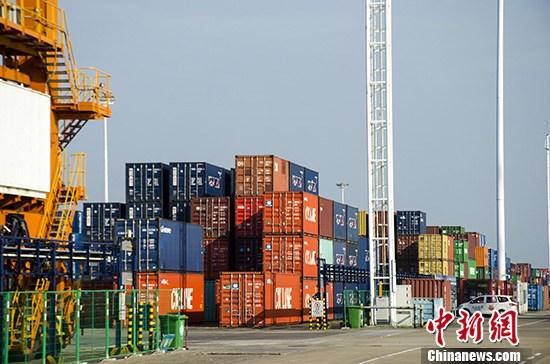China News Service, Beijing, December 23. Title: Will China's foreign trade continue to write "speed and passion" in 2021?
China News Agency reporter Li Xiaoyu
"Accident" is the key word for China's foreign trade in 2020: in the accident of the new crown pneumonia outbreak, China's import and export performance has achieved an accident that far exceeded expectations.
Based on a series of favorable factors, China's foreign trade is expected to continue to stage "speed and passion" in 2021.
Data map: Container terminal operation area in Guangxi Qinzhou Free Trade Port Area.
Photo by China News Agency reporter Zhai Liqiang
Positive one: global economic recovery is expected
To a large extent, foreign trade depends on the "face" of overseas markets.
With the acceleration of vaccine development and inoculation process, after experiencing the most severe recession after World War II, the world economy and trade may come out of the trough next year, which laid the foundation for China's foreign trade to maintain a positive momentum.
Zhu Jianfang, chief economist at CITIC Securities, predicts that in 2021, global demand will see a significant year-on-year growth, which is likely to be better than in 2020, which will have a strong pulling effect on China's export demand.
But this also means that China's export "outstanding" situation may be broken.
This year, China’s foreign trade, especially exports, has seen a year-on-year growth rate one month after another, even with a high level of more than 10%. This is related to the fact that many countries’ industrial chains and supply chains have been severely damaged or even "shut down" under the epidemic, and China’s competitive advantages have quickly become apparent.
Xu Qiyuan, a researcher at the Institute of World Economics and Politics of the Chinese Academy of Social Sciences, said that due to the prevention and control of the epidemic, the progress of the resumption of production and the economic recovery, it takes a leading position in the world’s major economies. China’s exports to other countries have formed a substitution effect, so exports are against the trend. Greatly increased.
As the world gradually passes the peak of the epidemic and economic activities return to normal, this substitution effect will weaken, and China's export growth rate and market share will return to normal levels.
UBS Asia Economic Research Director Wang Tao also believes that considering that the world economy will resume growth next year, consumer demand is expected to rebound sharply, and China's exports will continue to maintain strong growth, but the growth rate may not be as prominent globally as this year.
Good thing two: a series of trade agreements will inject a "booster" into China's foreign trade
As a giant free trade agreement covering approximately 30% of the world’s population, total economic volume, and total trade volume, the Regional Comprehensive Economic Partnership Agreement (RCEP) has been officially signed and entered into the domestic approval process in some member states.
Once the RCEP is officially in effect, the scale of bilateral trade between China and its largest trading partner, ASEAN, will be further expanded, and the industrial chain and supply chain will also accelerate integration, which will play a significant role in promoting China's foreign trade "to the next level."
As China’s Vice Minister of Commerce and Deputy International Trade Representative Wang Shouwen said, the RCEP will help expand China’s export market space, meet domestic import consumption needs, strengthen regional industrial chain supply chains, and help stabilize foreign trade and foreign investment.
In addition, China and Europe signed an agreement on geographical indications in September this year.
This is the first major trade agreement between China and the EU in recent years, including wine, tea, agricultural products, food and other Chinese geographical indications in the protection list, which will further promote the export of related products to Europe and expand the scale of China-EU trade.
Good news three: After the epidemic, Chinese foreign trade companies have significantly improved their ability to withstand pressure and their competitiveness
According to official data, the import and export volume of private enterprises in the first 11 months of this year increased by 11.3% year-on-year, accounting for 46.4% of China's total foreign trade value, an increase of 4 percentage points from the same period last year, and ranking firmly as China's largest foreign trade entity.
Among them, exports increased by 12.2%, accounting for 55.5% of the total export value.
Private enterprises have always been known for their quick response and strong resilience, and they are the "stabilizers" of foreign trade.
The increase in the proportion of private enterprises means that China has a more solid foundation for stabilizing foreign trade.
Many companies are still actively exploring the path of transformation, and new trade formats and new models are ushering in explosive growth.
Official data show that in the first three quarters, China's imports and exports through the customs cross-border e-commerce management platform increased by 52.8% year-on-year; market procurement exports increased by 35.5%.
This will also provide important support for the steady improvement of foreign trade next year.
In recent years, China’s foreign trade situation seems to be "more severe and complex" year after year, but the results are impressive every year.
In 2020, when global trade is falling precipitously, China's foreign trade has not only failed to recover, but its position has become more stable.
With the improvement of the internal and external environment next year, it should not be an "accident" that China's foreign trade station will reach a higher level.
(Finish)

